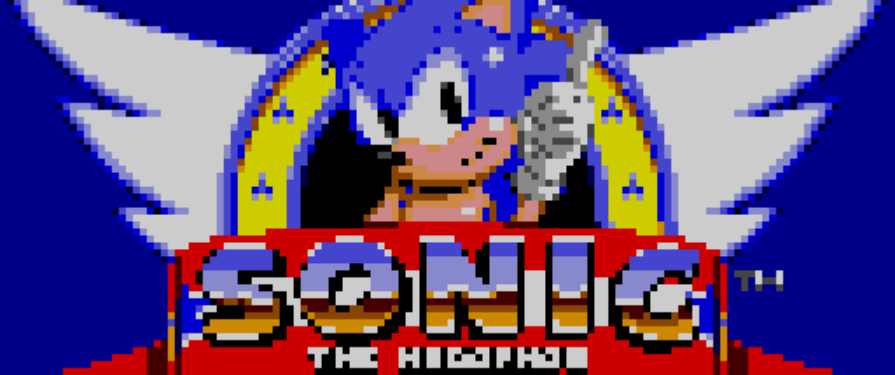I’m relatively new to the world of PC Sonic hacks. As I’ve never been much of a PC gamer, I never had much inclination to check out PC-only Sonic hacks until I decided to help cover last year’s Sonic Hacking Contest. Sonic ROM hacks are a different story, however. I’ve been exploring those for nearly a decade now, on my actual SEGA Genesis, through my Mega Everdrive or SEGA CD, as I’ve always loved the novelty of seeing these games running on my actual, ancient gaming hardware. I’ve played some true technical marvels over the years, but I don’t think any have impressed me quite as much as Vladikcomper’s Sonic the Hedgehog Blastless DX. An improved version of an April Fools hack released earlier this year, Blastless DX is a technological showcase with a fun premise: Sonic 1 has “lost” its blast processing, and the player needs to restore it.
Before getting into the game, I’ll explain exactly what “blast processing” is, in case you don’t know. It was a fancy marketing term SEGA of America used to highlight the SEGA Genesis/Mega Drive’s CPU speed, which was faster than the Super Nintendo, making speedy games like Sonic easier to make on the machine (SNES devs did eventually figure out how to get around this limitation, but it did plague early games like Gradius 3). Faster CPU aside, however, blast processing was little more than a marketing buzzword, and a key part of this game’s joke.
So, what does Sonic 1 look like without “blast processing”? An 8-bit demake, apparently. The central goal of the hack is to restore “blast processing” by filling up a blast processing bar in the bottom right of the screen, and keep it from emptying until the end of the level. Doing this successfully will “restore” an act, and essentially replaces the chaos emeralds, which can’t be gathered here. The bar can be filled up by gathering rings, destroying enemies, and smashing breakable walls. The bar is emptied whenever damage is taken, downgrading the game’s visuals to less powerful hardware. It’s here where this hack truly shines.
In addition to the 8-bit Master System visuals, there are two lower rungs of visual fidelity, which are reached after taking damage. Getting hit in Master System mode will downgrade visuals to “Atari.” Not the Atari 2600/VCS you’re probably familiar with, but an Atari 8-bit computer (at least, I think, because I know VCS games never looked this good.) Get hit in Atari mode, and visuals are downgraded further, to the colorless, green scale Game Boy. If these visual changes weren’t enough, each graphics mode also has its own music track and sound effects.
These changes are instantaneous, which makes it all the more wild that this actually works on real hardware. I’m used to the more impressive hacks requiring PC emulators, and so the fact that this is all being done with a stock SEGA Genesis absolutely astounds me. And what’s even wilder? This is actually fun to play. It’s more than just a gimmick. It changes how I play the game, and it’s fun.
Because chaos emeralds are no longer in play and I have incentive to seek out enemies and breakable objects, I actively seek that stuff out in the level. The blast processing bar is constantly draining, so I’m incentivized to both try to get through a level quickly, and also clear that level out as thoroughly as possible. Taking damage also carries different penalties, since it can result in multiple visual downgrades, which makes filling the blast processing bar before the end more difficult.
And the visual modes themselves look and sound really cool. The 8-bit mode looks like an 8-bit demake of Sonic 1 that’s graphically taxing the hardware, with accurate looking sprite art and loads of sprite flicker for moving background objects. The accompanying music tracks sound like genuine downgrades, but are also kind of catchy in their own ways. The Atari mode is probably the least impressive of the graphical modes to me, though that might be because I’m not very familiar with how those games looked and sounded, but it at least looks noticeably different and less advanced visually. Game Boy mode is thoroughly impressive, bringing Sonic 1 down to something that does kind of look like something from the platform, albeit without much in the way of music.
Perhaps my only real issue with all this is that these modes do include some graphical issues that may or may not be intentional. The sprite flicker might be a little much, and I do wonder if that’s just the Genesis buckling under everything it’s being asked to do. In Game Boy mode, there are brief moments where Sonic himself will disappear. And with every downgrade, in-game text becomes more and more indecipherable. I didn’t find these issues to affect playability much, but if things like sprite flicker bothers you, this hack might not be for you.
On my Tuesday SHC stream, someone in chat told me Vlad is a magician when it comes to coding for the Genesis. It’s kind of impossible for me to disagree on that front. I don’t know how he did it, whether he really managed to get it to switch between multiple kinds of graphics, or if he employed some sort of visual distorter or filter. But regardless of whatever tricks he used, I find them truly impressive, and Blastless DX is easily one of my favorite retro hacks to come out of Sonic Hacking Contest 2021. Check it out!





